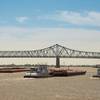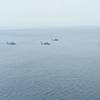Buoys in Disputed Waters Roil South China Sea Dispute
Buoys stretched "as far as eye could see" - Philippine sailor.
The Philippine navy recently found a large steel marker bearing Chinese inscriptions and hundreds of yellow buoys in waters near the Reed Bank, an area of the South China Sea where Manila has long explored for oil and gas, Philippine naval sources said.
One source, a sailor, told Reuters he was on a fishing boat being used by the navy that discovered the rubber buoys and the floating steel marker at the end of May. The buoys stretched "as far as the eye could see", the sailor said.
He said there was no evidence Chinese ships had placed them near the Reed Bank, which is also claimed by Beijing.
But efforts to remove the buoys were thwarted by the sudden appearance of a Chinese naval patrol vessel, prompting the Philippine boat to flee, the sailor said in an interview in Puerto Princesa, capital of Palawan province, the Philippine military's jumping off point to the disputed South China Sea.
The Reed Bank lies 80-90 nautical miles (148-167 km) west of the Philippines in what Manila regards as its 200-nautical mile exclusive economic zone (EEZ).
"Our boys tried to cut and remove the buoys but a large Chinese patrol ship emerged on the horizon and they hurriedly left," the sailor said, adding it was unclear what the Chinese inscriptions on the steel marker said.
The discovery was confirmed by two senior Philippine naval officials. One said the buoys were still there when the navy checked in the middle of June, although the steel marker was gone. No attempt was made to remove the buoys, he said.
The three sources declined to be identified because they were not authorised to speak to the media.
Philippine military officials said it was the first time in recent years that such markers had been found near the Reed Bank.
The Spratly islands, where China is flexing its naval muscles as it builds seven man-made islands on top of coral reefs, lie to the southwest of Reed Bank, further away from the Philippines.
Asked to comment on the buoys, the Chinese Foreign Ministry said "we do not understand what you are talking about", while adding that China had "indisputable sovereignty" over the Spratly islands and its nearby waters.
"China's position on this is clear and consistent," it said.
The Chinese Defence Ministry did not respond to a request for comment.
Marine Colonel Edgard Arevalo, the Philippine navy spokesman in Manila, said he had not seen any report on the discovery.
China claims most of the South China Sea, through which $5 trillion in ship-borne trade passes every year. The Philippines, Vietnam, Malaysia, Brunei and Taiwan also have overlapping
claims.
FOCUS ON OTHER SHOALS TOO
Philippine military strategists have long worried that China wants to occupy the Reed Bank.
One air force general said he suspected the buoys were put there so Chinese fishermen could tether their boats, then if the Philippine navy tried to evict the fishermen, Chinese coastguard
ships would appear to protect them.
In 2012, China seized Scarborough shoal, which lies 124 nautical miles (230 km) west of the Philippines, after a three-month standoff with the Philippine navy.
China has since prevented Philippine fishermen from getting close to the rocky outcrop's rich fishing grounds, the Philippine government and fishermen say.
The Philippine navy has previously found markers with Chinese inscriptions around shoals in other parts of the South China Sea that Manila claims.
In 2011, a steel marker the size of a 14-footer container was discovered in Sabina shoal in the Spratlys. A navy boat towed it away while concrete markers found in the same area last July were blown up, naval officials said.
The Philippine government said in March it was suspending exploration at Reed Bank while it pursued international arbitration over its territorial dispute with China at a U.N. tribunal in the Hague.
Manila is seeking a ruling to confirm its right to exploit waters in its EEZ as allowed under the U.N. Convention on the Law of the Sea. China has refused to participate in the hearing, which opens on Tuesday.
By Manuel Mogato










